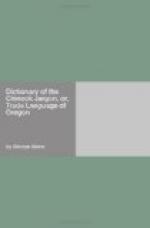With regard to the form into which this dictionary has been thrown, an explanation is necessary. The Jargon must in some degree be regarded as a written language, the orthography of which is English. In Mr. Hale’s vocabulary alone has one more scientific been attempted, and of several other printed, and numerous manuscript dictionaries in circulation, M. Lionnet’s alone, that I have met with, is according to the French. Although no fixed system of spelling exists among them, I have therefore deemed it best to preserve for the Jargon words that which most distinctly represents the common English pronunciation; while for the Indian derivations, I have adopted that recommended by the Smithsonian Institution in collecting Indian vocabularies, using the Italian sounds of the vowels, and representing the guttural of the German ich by kh. This seemed the more proper, as the work would thereby be rendered of practical use, independent of what philological value it may possess.
In collating the words of the present work and obtaining their derivations, I have been assisted by a number of friends; among whom I should specially mention Mr. Alexander C. Anderson, of Victoria, V.I., and Mr. Solomon H. Smith, of Clatsop, Oregon.
Bibliography of the Chinook Jargon.
Journal of Travels over the Rocky Mountains. By Rev. Samuel Parker. 12mo. Ithaca, N.Y., 1838.
“Vocabulary of the Chenook language, as spoken about Fort Vancouver,” pp. 336-338.
Ethnography and Philology of the United States Exploring Expedition. By Horatio Hale. 4to. Philadelphia: Lea & Blanchard, 1846.
A vocabulary of the “Jargon or Trade Language of Oregon,” with an essay thereon, and phrases, is given in this work, pp. 636-650.
Transactions of the American Ethnological Society. 2 vols., 8vo. New York: Bartlett & Welford, 1845, 1848.
In vol. ii., pp. 62-70, under title of “Hale’s Indians of Northwest America,” is a partial reprint of the above.
Rev. Z.B.Z. Bolduc, “Mission de la Colombie.” 8vo. Quebec, 1843.




